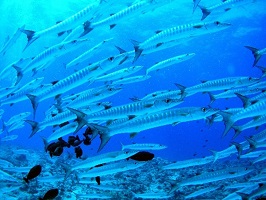Ciguatera Poisoning

Ciguatera poisoning (CP) is a type of poisoning associated with the consumption of seafood with an estimate number of 20,000–50,000 poisonings per year worldwide. Although epidemiological studies indicate that less than 10 % of actual cases are ever reported. In general, under-diagnosis and under-reporting make it difficult to know the true worldwide incidence of the diseases related to marine toxins. CP is endemic in tropical and subtropical regions of the world. Isolated outbreaks have occurred sporadically but with an increasing frequency in temperate areas such as Europe.
This seafood-borne illness is typically caused by the consumption of fish that have accumulated ciguatoxins in their flesh.
Ciguatoxins are produced by benthic dinoflagellates from the genus Gambierdiscus spp. that represents a key aspect in studies of harmful algae in recent years due to the danger to human health.
Consumers eating contaminated fish can suffer from a range of symptoms including gastrointestinal, cardiovascular and neurological effects. There is no cure for this toxin, although treatments are available. Some people remain experiencing symptoms years after the intoxication.
In Europe, autochthonous ciguatera food poisoning (CFP) outbreaks were reported in Spain (Canary Islands) and in Portugal (Madeira). In Spain an outbreak occurred in 2004 associated with consumption of amberjack fish (Seriola spp.) captured in Canarianwaters. The epidemiological Surveillance System for Ciguatera poisoning in the Canary Islands recorded 11 indigenous outbreaks of ciguatera food poisoning between 2008 and 2014, accounting for 96 cases. In the case of Madeira, an outbreak of ciguatera was reported in 2008, due to consumption of amberjack fish (Seriola spp.) caught in local waters. Some studies were able to identify the presence of Gambierdiscus spp. in waters of the Canary Islands, Madeira and in the Mediterranean.
If you want to find any information related to this website, please use the search application on the top of the page
















